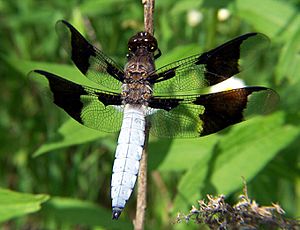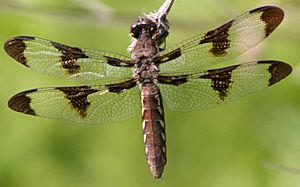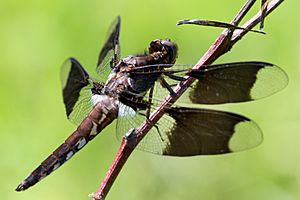Common whitetail facts for kids
Quick facts for kids Common whitetail |
|
|---|---|
 |
|
| Adult male | |
 |
|
| Adult female | |
| Scientific classification | |
| Kingdom: | |
| Phylum: | |
| Class: | |
| Order: | |
| Suborder: | |
| Family: |
Libellulidae
|
| Genus: |
Plathemis
|
| Species: |
P. lydia
|
| Binomial name | |
| Plathemis lydia (Drury, 1773)
|
|
| Synonyms | |
|
|
The common whitetail (Plathemis lydia) is a cool dragonfly you can find in many parts of North America. It's also sometimes called the long-tailed skimmer. These dragonflies have a unique look that makes them easy to spot.
Male common whitetails have a thick, white body, about 5 cm (2 inches) long. Their clear wings have brownish-black bands, giving them a checkered pattern. Female whitetails have a brown body. Their wing spots look a bit like those of the Twelve-spotted skimmer. You can tell female whitetails apart because they are smaller. They also have white zigzag stripes on their belly, while the other species has straight yellow stripes.
You can often see common whitetails flying over ponds, marshes, and slow-moving rivers. They hunt for mosquitoes and other small flying insects. They live in most regions, but not in very high mountain areas. In places like California, you can see them flying from April to September.
Common whitetails are "perchers," meaning they often rest on things near the water. They might sit on plants or even on the ground.
Contents
Life at the Pond
Male common whitetails are very protective of their space. They claim a section of the water's edge, usually about 10 to 30 meters long. They fly around this area to chase away other males. Older males have a white, powdery coating on their belly called pruinescence. They show this white belly to other males as a warning to stay away from their territory.
What Whitetails Eat
Baby common whitetails are called nymphs. They are dark green or brown and often covered in algae. Nymphs live in the water and eat other small water creatures. This includes things like mayfly larvae and tiny crayfish. They also eat small water animals like tadpoles and minnows.
Because there are so many whitetail nymphs, they are an important food source for other animals. Fish, frogs, birds, and even other water insects eat them.
Mating and Eggs
Female common whitetails visit ponds to lay their eggs, a process called oviposition. Male dragonflies try to mate with the females when they come to the pond. Females can be picky and might reject many mating attempts.
Females usually lay their eggs in the middle of the day. They look for the best spots in the pond to drop their eggs. Males often compete fiercely for territories that are good for egg-laying. This competition creates a pecking order, where stronger males get the best spots and have more chances to mate.
Strong Fliers
Male dragonflies need strong flight muscles to fight off other males. Most of a male common whitetail's body weight is made up of these powerful muscles. This helps them win aerial fights. However, having such big muscles means they have less room for food storage, like fat. So, they have to balance being strong fliers with having enough energy reserves.
Laying Eggs Safely
Females need to find a good place to lay their eggs because temperature affects how well the eggs develop and hatch. They often lay their eggs in water, mud, or on plants.
To keep their eggs safe, females use different tricks. They might lay eggs in several different spots. This way, if one spot isn't safe, not all their eggs are lost. They often flip their abdomen to scatter the eggs widely. Females might also choose smaller bodies of water where there are fewer fish that could eat the eggs. Once the eggs are laid, the mother dragonfly doesn't care for them.
Life Cycle of a Dragonfly
Like all dragonflies, common whitetails spend most of their lives as nymphs living in the water. During this stage, many nymphs don't survive, often due to predators or drying out.
After the nymph stage, they become adult dragonflies. The adult stage only lasts a few weeks. During this short time, adult common whitetails mate and lay their eggs, starting the cycle all over again.
How Dragonflies Fly
Common whitetails are built for fast flight. They have wide wings and very strong muscles to move them. To power these muscles, they need a lot of oxygen. Dragonflies have a special breathing system with many tubes called a tracheal system.
When they are nymphs living in the water, they don't use their wings. So, some parts of their breathing system that would be used for flight aren't active during that time.
Images for kids
Citizen science observations for Common whitetail at iNaturalist







